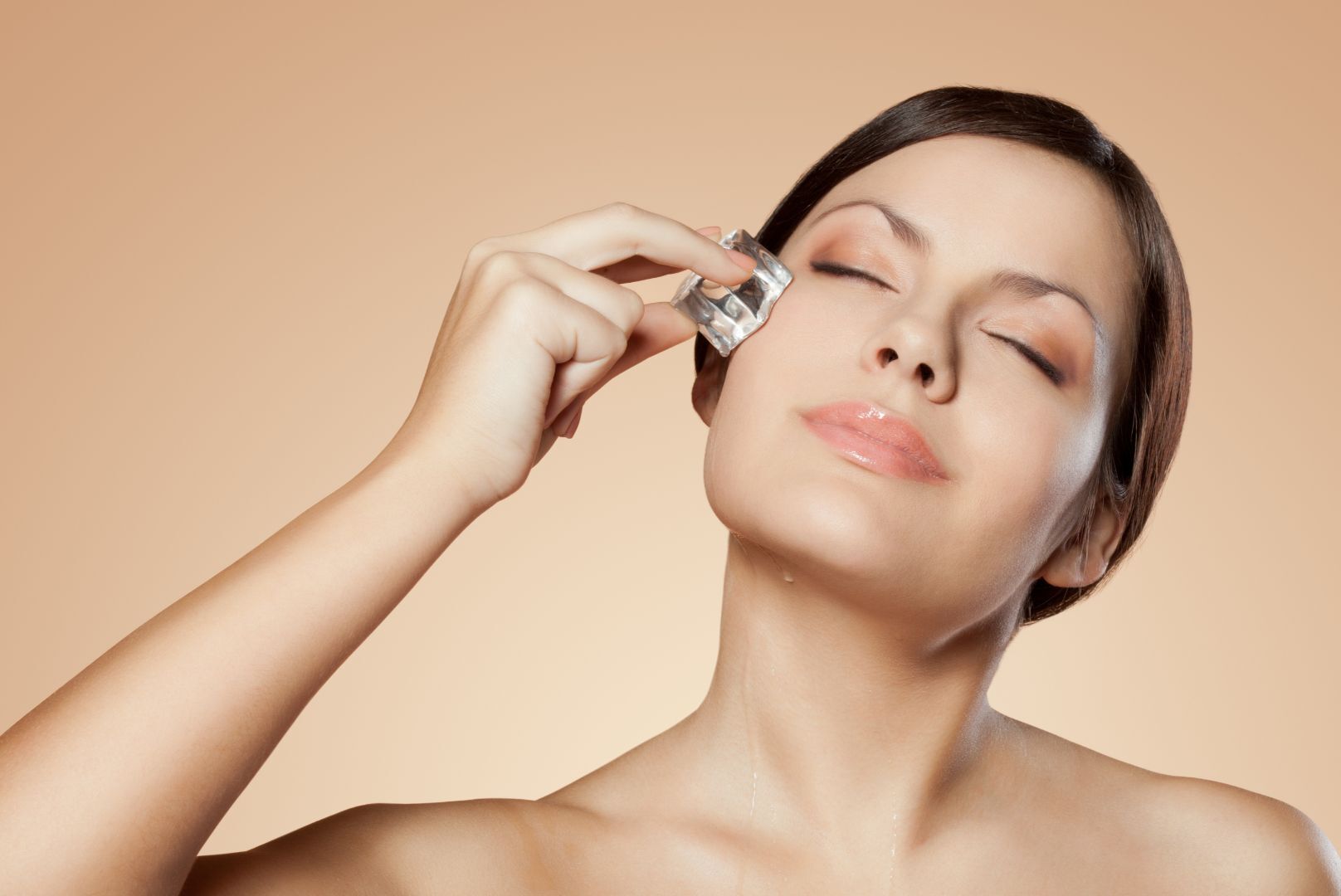

Red, flushed skin can be attributed to a number of things, whether it's warm weather, an intense workout, or simply feeling excited or embarrassed. Sometimes redness can occur because of a skin condition, such as rosacea, or issues like endocrine disorders that we can't easily see. While some causes of redness are a bit easier to treat than others, and perhaps only require a pat-down with cool water or a calming mask, others require intensive treatments with the help of a skincare pro. Whatever the case, calming red, flushed skin is easier once you identify the cause.
Keep reading to learn more about what you can do to calm your skin when redness occurs.
1. Apply a Cool Compress
If your red or flushed skin isn’t due to an underlying medical condition, you can treat it by applying a cool compress to the affected area. In most cases, the skin becomes flushed as a result of the blood vessels widening, which then allows for more blood to flow through. This is why some people experience redness during exercise, when they drink alcohol, or if they become embarrassed—which we'll get to in a minute.
To calm flushed skin, place a clean washcloth in a plastic bag filled with ice cubes and leave it in the freezer for about 15 minutes. Then, remove the cloth and gently apply it to the skin for about 20 minutes.
2. Color-Correct With Visine
For years, Visine has promised to “get the red out” of our eyes, and as it turns out, that same color-correcting magic can work on skin. Like ice or cold water, Visine constricts blood vessels to reduce redness by restricting blood flow to the area. Many people already know that a few drops of Visine on an inflamed pimple can offer temporary relief from redness, and to implement this practice to any affected areas of the skin by combining a little Visine mixed with moisturizer.
3. Wear a Soothing Mask
If you don’t need to constrict your blood vessels but seek to calm red skin that’s caused by dryness or inflammation, natural face masks and sheet masks make for great at-home treatments when they contain the right ingredients. Rosewater is known for reducing redness and calming irritated skin. Plus, it's naturally packed with vitamins A, C, and E, which will leave your skin looking and smelling fantastic in mere minutes.
4. Regularly Moisturize
Moisturizing should already be a part of your skincare routine, but if you experience chronic redness, it may be time to boost the frequency. Look for soothing ingredients in your moisturizers like aloe, spring water, or oatmeal. If you still can't shake the dryness, try incorporating a hyaluronic acid serum into your routine.
5. Look Into Lasers
Laser technology has been used by dermatologists for years to treat a number of skincare concerns, from reducing acne scarring, to diminishing hyperpigmentation, and even lifting sagging skin without requiring patients to go under the knife. When it comes to relieving redness, there’s a laser therapy treatment for that, too. V-Beam Laser is a non-ablative laser that produces an intense but gentle burst of light that selectively destroys the blood vessels of vascular lesions without damaging the surrounding skin and tissue. This laser helps with flushing as well.
The KTP laser is another option, which literally cauterizes the dilated vessels that cause redness in the first place. Other lasers, such as laser genesis, help patients with rosacea and acne combination by destroying the bacteria that causes acne and helping the skin to heal itself.
6. Avoid Irritating Products
Redness can be exacerbated by certain ingredients in our skincare—namely acids, which are commonly used to exfoliate the skin. Steer clear of strong retinoids or retinol, as these products can further irritate sensitive skin, as well as harsh physical exfoliants and polishing scrubs. Some acne products can be drying and should be used with caution if you have sensitive skin, such as benzoyl peroxide, salicylic acid, and glycolic acids.
If you can’t part ways with your favorite acid-enhanced product, limit your use to just a few times a week or look to formulas that contain a low percentage of the good stuff. For example, many products containing glycolic acid may fall between 10 to 20 percent glycolic acid.
Even if you're not using harsh acids, it's a good idea to use a gentle cleanser twice daily. Also, apply a moisturizer with SPF 30 or higher every morning, and use a nourishing moisturizer at night. You can try using a low-dose retinol as well.
7. Revise Your Diet
Underlying redness can simply be related to a few outside factors. This is, of course, if you're not dealing with a certified medical condition. If your redness is less medical and more environmental, sometimes it can be broken down into making simple changes in things like your diet. Trying an anti-inflammatory diet, which includes green leafy vegetables, fish, essential oils, and low-glycemic fruits. Even more importantly it excludes simple sugars, grains, non-organic meats and dairy, and high-glycemic fruits. Pre- and probiotics are a must. Vitamin D supplements also help, even in those patients with normal vitamin D levels.
In the same way that certain skincare ingredients may trigger the outer layer of the skin, some foods and drinks can inflame and irritate skin from the inside. These foods tend to have high acidic content and can regularly produce flushed cheeks and persisting redness. If you are prone to redness or rosacea, then you can avoid triggers, such as spicy foods, citrus, tomato, chocolate, and cinnamon. Additionally, heat, extremes in temperatures (either hot or cold), wind exposure, alcohol, and some warm beverages as additional triggers that can lead to redness or may induce rosacea symptoms.
8. Make Lifestyle Changes
While persisting redness can be a frustrating problem, the cause is often more than skin deep. This means that the solution can require certain lifestyle changes in addition to the steps mentioned above. For lifestyle modifications you can make the following:
- Decrease sun/UV exposure
- Stop smoking
- Stop drinking hot beverages
- Drink cold water while exercising
While this won't necessarily "cure" redness, doing things like avoiding excessive sun exposure or using a cool compress can help reduce symptoms temporarily.
9. Try a Multifactorial Approach
Sometimes skin redness or flushing requires treatments and ingredients that at-home DIY solutions can’t offer. Calming red skin depends on its cause, especially when dealing with a skin condition. Rosacea is the most common cause of facial redness. The best approach to treating this is multifactorial. It includes a combination of nutrition and lifestyle modification, skincare, medications, and procedures, such as laser.
Procedures such as microneedling with platelet-rich plasma (PRP), which are anti-inflammatory, can often help those that have an acne/rosacea combination. Microneedling works by resurfacing the skin and decreasing inflammation.
10. Wear Sunscreen
Though it may seem obvious, sunscreen is often the most neglected part of a skincare routine. Yes, an SPF 30 or above shields your skin from harmful UV rays and prevents burning, but it also helps reduce unwanted flare-ups.
Heat and sun exposure often trigger skin conditions like rosacea and melasma.
11. Minimize With Makeup
Redness relief exists, but unfortunately, most solutions are not immediate. If you are struggling with fading redness, try applying a color corrector. Green is the opposite of red, so look for a cream or concealer tinted with a greenish hue to erase rosy tones.
12. Talk to Your Doctor
If other options have been exhausted and you still can’t find relief from redness or flushing, it is always a good idea to consult your physician, especially if redness is combined with additional symptoms.
If the red, flushed skin is associated with a rapid heart rate, sweating, and/or diarrhea, that is something more concerning that warrants further workup. Carcinoid tumors or pheochromocytomas are tumors that can cause flushing and a racing heart, for example. Most cases of flushing, however, are just a benign genetic tendency.
13. Rosacea Skin Care
Whether you try the intense options or the subtler ones, the one thing you should change to help soothe your red skin is your skin care products. Wild Naturals has natural, anti-inflammatory products created to soothe, nourish, hydrate, and restore skin! From eczema to acne, we help them all. Shop Wild Naturals today!


